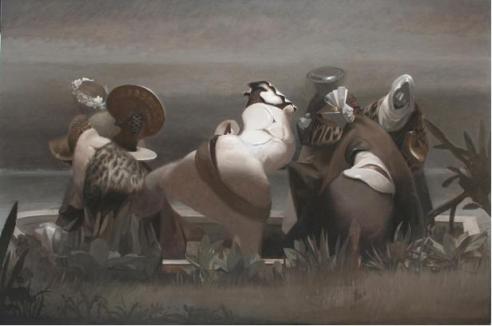
Nick Devereux, "Amnion," 2013. Oil on canvas, 240 x 160 cm. Courtesy of the artist, Art At Work and Galerie Bugada & Cargnel.
Fondazione Querini Stampalia
Art At Work
Nick Devereux
Inpainting
May 29–June 30, 2013
Opening: May 28, 6–10pm
Preview breakfast by invitation: May 29, 10am–noon
A project by Art At Work with the support of Galerie Bugada & Cargnel, Paris
Fondazione Querini Stampalia
Santa Maria Formosa, Castello 5252
30122, Venice
Hours: Tuesday–Sunday 10am–6pm
www.artatwork.it
Inpainting is artist Nick Devereux's (b. 1978; Panama City) first solo show in an Italian institution. This articulated project expands on Devereux's investigation of the visual system and focuses on ideas of perception and representation, questioning those which are considered to be established and fixed codes in art history. Appropriating and reformulating images and their subject matter, Devereux's works generate an animation of a certain portrayal of the past, creating a short circuit between the acknowledged and the undisclosed, between the apparently familiar and the arcane. For Inpainting, at Fondazione Querini Stampalia, the artist embarks on a completely new research, starting from the text in which Pausanias, the Greek traveller and geographer of the II century AD, known for Description of Greece, diligently describes in this ten-volume cultural geography of the Greek territory, the now-destroyed frescoes of Polygnotus at Delphi.
After an exhaustive study and analysis of the narrative, Devereux decided to elaborate the information recounted by Pausianias, both through references to the historical context as much as through his personal observation and interpretation of the specific images. Paring down the text to the objects, gestures and landscapes described, the artist developed a new version of the script composed exclusively by tangible fragments derived from the original piece.
Inpainting gathers a series of paintings, referencing those same symbolic fragments, selected, isolated and transformed by Devereux, which together reconstruct an abstract and mystified script alluding to the original oeuvre. Devereux's research explores and morphs the structure and authority of the icon, freeing potential and unexpressed associations, while simultaneously eluding illustrative representation.
The essence of the title of the exhibition itself, Inpainting alludes to a particular conservation technique, based on the process of reconstructing lost or deteriorated parts of images, through a precise and minimal intervention, necessary for the new unity of the work. Devereux applies a very similar procedure to his paintings by suggesting new alliances and significations when recomposing the form. Working within a theory of vision the artist traces and outlines the terms representation and identity exploring the integral nature of the image, while questioning the origin of its source. The artist's paintings are perceptive games which aim at demolishing immutable beliefs, arguing the illusion of truth. In the works shown at Fondazione Querini Stampalia, minimal geometrical constructions interfere with the main figures, subtracting their specific identities. Devereux's gesture disrupts the scene and the classical visual display, provoking an effect of disorientation to the viewer's allured eye. The recurring vertical form becomes an emblem, generating a new epic, or better a hybrid: the synthesis of the origin and the process. Inpainting thus reveals a translation of history and figuration liberating Pausanias' text from its terms of recognition, stating the uncertainty of knowledge and the infinite potentials of vision, interpretation and narration. Devereux plays with the time and space described in the mythical, hence underling how a deviation in the perception of history's images can free not only what we know but also what has fallen into oblivion.
Press: Simona Cupoli
mail@artatwork.it / T 39 333 6584 092




